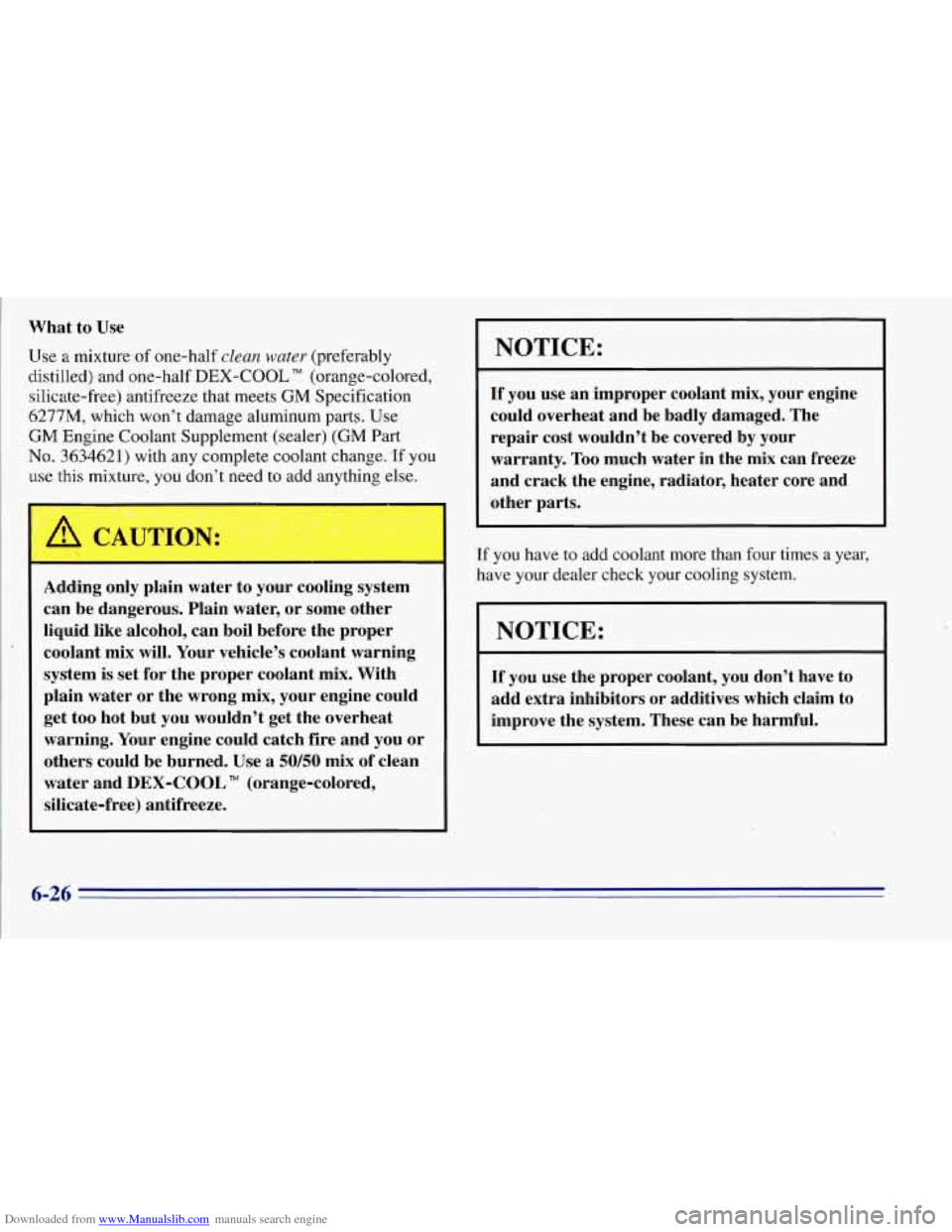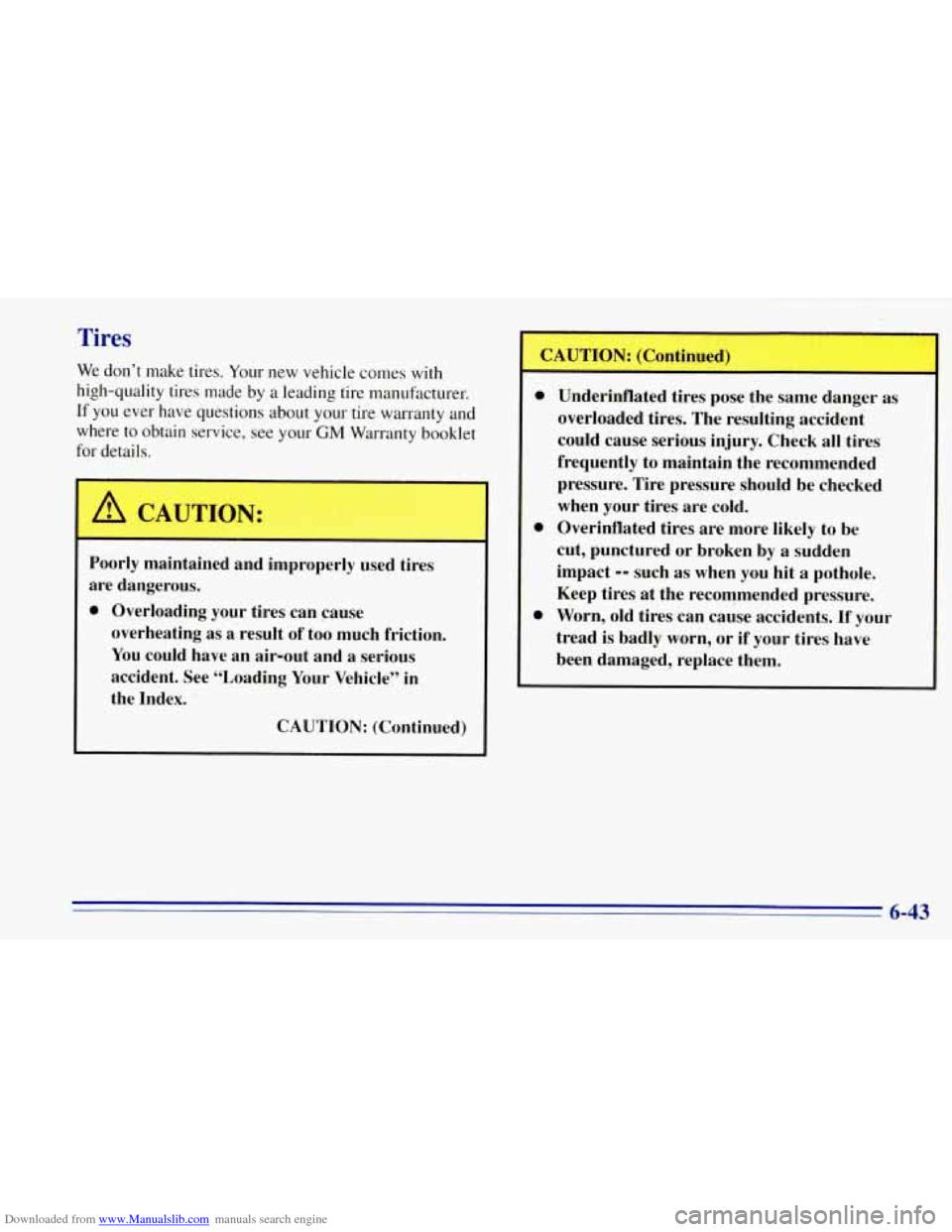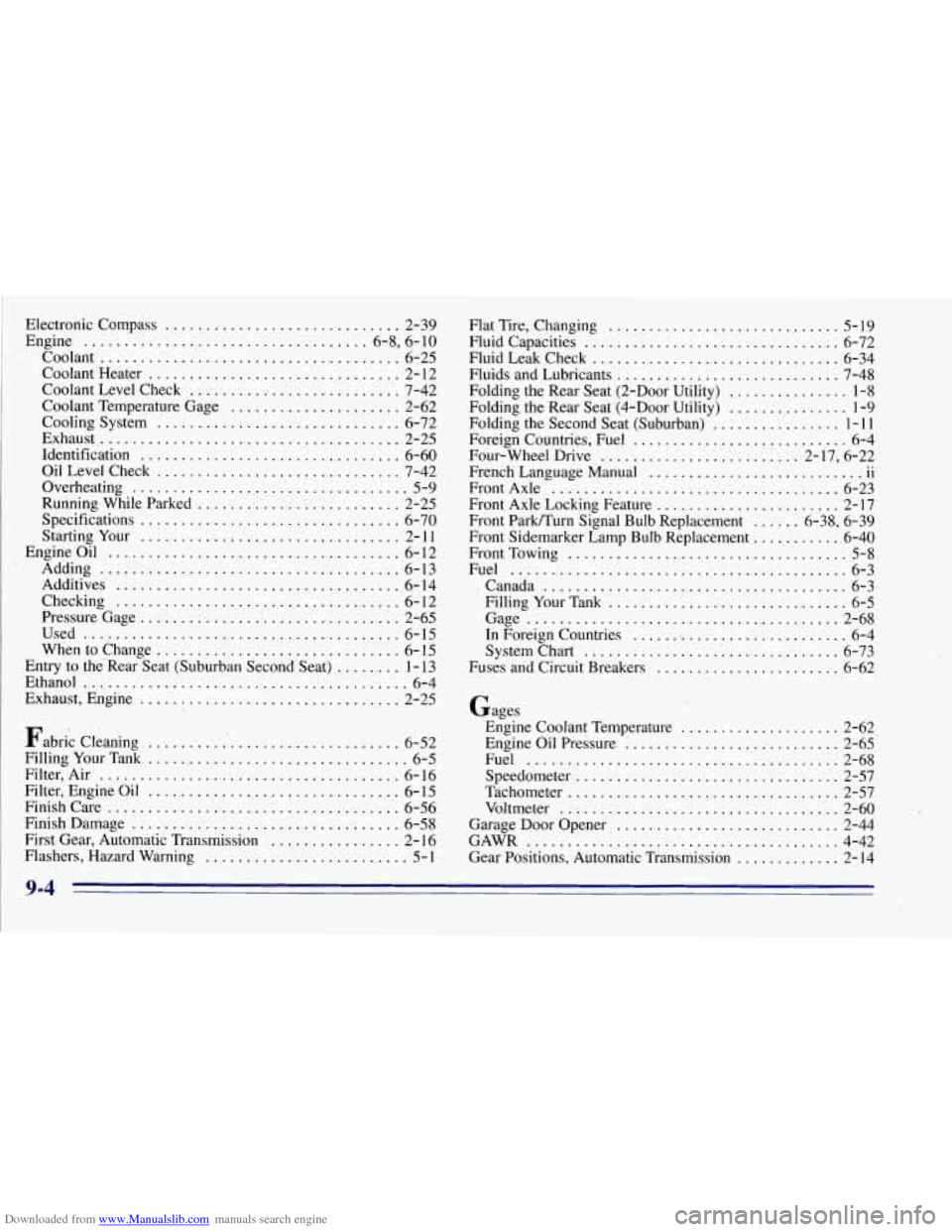Page 279 of 403

Downloaded from www.Manualslib.com manuals search engine What to Use
Use a mixture of one-half clean water (preferably
distilled) and one-half DEX-COOL
TM (orange-colored,
silicate-free) antifreeze that meets
GM Specification
6277M, which won’t damage aluminum parts. Use
GM Engine Coolant Supplement (sealer) (GM Part
No. 3634621) with any complete coolant change. If you
use this mixture, you don’t need
to add anything else.
Adding only plain water to your cooling system
can be dangerous. Plain water, or some other
liquid like alcohol, can boil before the proper
coolant mix will. Your vehicle’s coolant warning
system is set for ‘the proper coolant mix. With
plain water or the wrong mix, your engine could
get too hot but you wouldn’t get the overheat
warning. Your engine could catch fire and you or
others could be burned. Use
a 50/50 mix of clean
water and
DEX-COOL TM (orange-colored,
silicate-free) antifreeze.
NOTICE:
If you use an improper coolant mix, your engine
could overheat and be badly damaged. The
repair cost wouldn’t be covered by your
warranty.
Too much water in the mix can freeze
and crack the engine, radiator, heater core and
other parts.
[f you have to add coolant more than four times a year,
have your dealer check your cooling system.
NOTICE:
If you use the proper coolant, you don’t have to
add extra inhibitors
or additives which claim to
improve the system. These can be harmful.
6-26
Page 281 of 403
Downloaded from www.Manualslib.com manuals search engine Radiator Pressure Cap
I
The radiator pressure cap must be tightly installed with
the arrows on the cap lined up with the overflow tube on
the radiator filler neck.
NOTICE:
Your radiator cap is a 15 psi (105 kPa)
pressure-type cap and must be tightly installed to
prevent coolant loss and possible engine damage
from overheating. Be sure the arrows on the cap
line up with the overflow tube
on the radiator
filler neck.
Thermostat
Engine coolant temperature is controlled by a thermostat
in the engine coolant system. The thermostat stops the
flow
of coolant through the radiator until the coolant
reaches a preset temperature.
When you replace your thermostat, an
AC@ thermostat
is recommended.
6-28
Page 296 of 403

Downloaded from www.Manualslib.com manuals search engine Tires
We don’t make tires. Your new vehicle comes with
high-quality tires made by a leading tire manufacturer.
If you ever have questions about your tire warranty and
where to obtain service, see your
GM Warranty booklet
for details.
A CAUTION:
Poorly maintained and improperly used tires
are dangerous.
0 Overloading your tires can cause
overheating as a result of too much friction.
You could have an air-out and a serious
accident. See “Loading Your Vehicle” in
the Index.
CAUTION: (Continued) CAUTION:
(Continued)
0
0
0
Underinflated tires pose the same danger as
overloaded tires. The resulting accident
could cause serious injury. Check all tires
frequently to maintain the recommended
pressure. Tire pressure should be checked
when your tires are cold.
Overinflated tires are more likely to be
cut, punctured or broken by
a sudden
impact
-- such as when you hit a pothole.
Keep tires at the recommended pressure.
Worn, old tires can cause accidents.
If your
tread is badly worn, or if your tires have
been damaged, replace them.
6-43
Page 314 of 403

Downloaded from www.Manualslib.com manuals search engine Electrical System
Add-on Electrical Equipment
NOTICE:
Don’t add anyth’ing electrical to your vehicle
unless you check with your dealer first. Some
electrical equipment can damage your vehicle
and the damage wouldn’t be covered by your
warranty. Some add-on electrical equipment
can keep other components from working
as
they should.
Your vehicle has an air bag system. Before attempting to
add anything electrical to your vehicle, see “Servicing
Your Air Bag-Equipped Vehicle” in the Index.
Headlamps
The headlamp wiring is protected by a circuit breaker in
the lamp switch. An electrical overload will cause the
lamps
to flicker on and off, or in some cases to remain
off. If this happens, have your headlamp wiring checked
right away.
Windshield Wipers
The windshield wiper motor is protected by a circuit
breaker and a fuse. If the motor overheats due
to heavy
snow, etc,, the wiper will stop until the motor cools.
Although the’circuit is protected from electrical
overload, overload due to heavy snow, etc., may cause
wiper linkage damage. Always clear ice and heavy snow
from the
the windshield before using the windshield
wipers. If the overload is caused by some electrical
problem and not
snow, etc., be sure to get it fixed.
6-61
Page 393 of 403

Downloaded from www.Manualslib.com manuals search engine Electronic Compass ............................. 2-39
Engine
................................... 6.8. 6.10
Coolant
..................................... 6-25
Coolant Heater
............................... 2-12
Coolant Level Check .......................... 7-42
Coolant Temperature Gage
..................... 2-62
Cooling System
.............................. 6-72
Exhaust
...................................... 2-25
Identification
................................ 6-60
OilLevelCheck
.............................. 7-42
Overheating
.................................. 5-9
Running While Parked
......................... 2-25
Specifications
. : .............................. 6-70
Starting Your
................................ 2- 11
EngineOil
.................................... 6-12
Adding
..................................... 6- 13
Additives
................................... 6-14
Checking
.................................... 6-12
Pressure Gage
................................. 2-65
Used
....................................... 6-15
Whentochange
.............................. 6-15
.Entry to the Rear Seat (Suburban Second Seat)
........ 1 - 13
Ethanol
........................................ 6-4
Exhaust, Engine
................................ 2-25
Fabric Cleaning
......... .1 ..................... 6-52
FillingYourTank
................................ 6-5
Filter, Air
..................................... 6-16
Filter, Engine Oil
............................... 6- 15
Finish Care
.................................... 6-56
Finish Damage
................................. 6-58
First Gear, Automatic Transmission
................ 2-16
Flashers, Hazard Warning
.......................... 5- 1
Flat Tire. Changing ............................. 5- 19
Fluid Capacities ................................. 6-72
Fluid Leak Check
............................... 6-34
Fluids and Lubricants
............................ 7-48
Folding the Rear Seat
(2-Door Utility) ............... 1-8
Folding the Rear Seat
(+Door Utility) ............... 1-9
Folding the Second Seat (Suburban)
................ 1-11
Foreign Countries. Fuel ........................... 6-4
Four-wheel Drive
......................... 2-17. 6-22
FrenchLanguageManual
11
FrontAxle ..................................... 6-23
Front Axle Locking Feature
....................... 2-17
Front Park/Turn Signal Bulb Replacement
...... 6-38, 6-39
Front Sidemarker Lamp Bulb Replacement
............. 6-40
FrontTowing
................................... 5-8
Fuel .......................................... 6-3
Canada
...................................... 6-3
Filling Your Tank
............................... 6-5
Gage
........................................ 2-68
In Foreign Countries ........................... 6-4
System Chart
................................. 6-73
Fuses and Circuit Breakers
....................... 6-62
.. ...........................
Gages
Engine Coolant Temperature
.................... 2-62
Engine Oil Pressure
i .......................... 2-65
Fuel
....................................... 2-68
Speedometer
................................. 2-57
Tachometer
.................................. 2-57
Voltmeter
................................... 2-60
Garage Door Opener.
............................ 2-44
GAWR
....................................... 4-42
Gear Positions, Automatic Transmission
............. 2-14
9-4 ~ ..
Page:
< prev 1-8 9-16 17-24